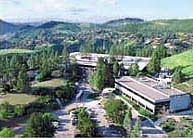 Rockwell Scientific Company (RSC)
Rockwell Scientific Company (RSC)
 Rockwell Scientific Company (RSC)
Rockwell Scientific Company (RSC)
From 1996 - 2005 I was employed as "Member of the Technical Staff" at
Rockwell Scientific in
Thousand Oaks.![]() When I joined, it was still called "Rockwell Science Center" (founded in 1962), the corporate research
laboratory of Rockwell, a 80,000 employee company. My initial work was in the area of computer
vision-based road recognition for a lane departure warning system.
When I joined, it was still called "Rockwell Science Center" (founded in 1962), the corporate research
laboratory of Rockwell, a 80,000 employee company. My initial work was in the area of computer
vision-based road recognition for a lane departure warning system.
![]() Shortly after I accepted the position and moved from Germany to California in April 1996,
Boeing decided to buy half of the Rockwell consortium: the defense and the aerospace segment of Rockwell.
For my work, that meant that the project I was working on, was not continued any more.
Shortly after I accepted the position and moved from Germany to California in April 1996,
Boeing decided to buy half of the Rockwell consortium: the defense and the aerospace segment of Rockwell.
For my work, that meant that the project I was working on, was not continued any more.
![]() Instead of lane tracking, my new projects became related to
Augmented Reality and wearable computing.
The remainder of Rockwell split off one by one: Rockwell Semiconductor became
Conexant, Rockwell Automotive became Meritor
and merged later with Arvin to
ArvinMeritor.
Instead of lane tracking, my new projects became related to
Augmented Reality and wearable computing.
The remainder of Rockwell split off one by one: Rockwell Semiconductor became
Conexant, Rockwell Automotive became Meritor
and merged later with Arvin to
ArvinMeritor.
![]() In 2001, the remaining business units of
Rockwell Collins and
Rockwell Automation split off into two
separate companies, and the former Rockwell Science Center became
Rockwell Scientific, or RSC,
an independent privately owned company conducting high-tech research.
It has a variety of research areas, stretchign form imaging, optics, electronics, material science,
to information technology.
This variety provides a very stimulating work atmosphere with a lot of
opportunities for cross-disciplinary discussions. A really great place to work!
In 2001, the remaining business units of
Rockwell Collins and
Rockwell Automation split off into two
separate companies, and the former Rockwell Science Center became
Rockwell Scientific, or RSC,
an independent privately owned company conducting high-tech research.
It has a variety of research areas, stretchign form imaging, optics, electronics, material science,
to information technology.
This variety provides a very stimulating work atmosphere with a lot of
opportunities for cross-disciplinary discussions. A really great place to work!
My general work area is in Information Technology. Although the specific projects have changed during my employment at RSC in 1996, the common theme has been the same: using computer vision technology for providing a computer with automatically obtained information. My first project was related to a driver warning system that would track road lane markings and issue a warning when the driver would (unintentionally) depart from that lane. Further projects shifted more into the domain of general human-computer interface / interaction. In my work, computer vision has played a central role of my research and development activities, in projects for visual marker tracking and identification, natural silhouette tracking, man-made infrastructure tracking. The common goal of these projects was to utilize computer vision as an automatic tool for obtaining the position / orientation of the camera relative to the environment. The application of this technology is for example in Augmented Reality (for registered fusion of information with the user's perception) or in object recognition and tracking systems.